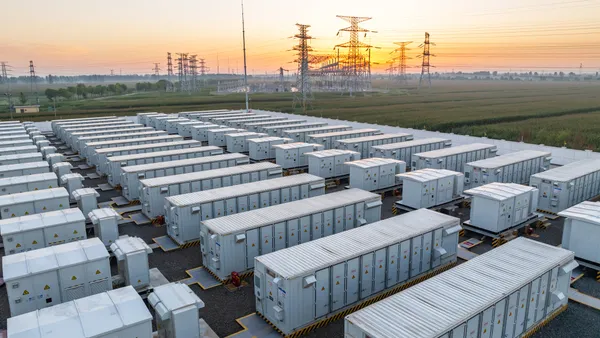Dive Brief:
- California regulators next month will consider a plan to replace three natural gas-fired power plants with energy storage, significantly building on the state's apparent comfort with batteries as grid solutions.
- The California Public Utilities Commission (CPUC) is scheduled to vote Jan. 11 on a proposal for Pacific Gas and Electric to issue a request for solicitations for storage projects that would replace the Metcalf Energy Center, Feather River Energy Center, and Yuba City Energy Center.
- The three power plants are no longer economical, but have been identified as necessary for reliability by the California Independent System Operator (CAISO).
Dive Insight:
California is considering energy storage to replace two peaking plants and one larger facility, the 580 MW Metcalf plant. It is not the first time the state has turned to batteries for a grid solution, but shows how the solution is becoming increasingly viable.
The Yuba City and Feather River plants are each about 47.6 MW, and are needed for capacity and high voltage sub-area shortfalls, respectively. Last month, CAISO determined that the entire Metcalf Energy Center was necessary for local reliability needs in a sub-area of the Bay Area local capacity area.
The CPUC proposal would order PG&E to hold at least one one solicitation to address "two local sub-area capacity deficiencies and to manage a high voltage issue in another sub-area." The utility can solicit bids for energy storage and other alternative energy resources individually or in aggregation.
Regulators have embraced energy storage in other recent situations to replace capacity, such as the Aliso Canyon gas leak.
In May 2016, the CPUC directed Southern California Edison (SCE) to conduct an expedited procurement for both utility-owned and third party storage resources to address the Aliso Canyon gas leak and resulting generator shortages.
It's not the first time SCE was asked to consider energy storage as an alternative capacity resource: in 2013, the CPUC required the utility to procure a minimum amount of energy storage and other alternative resources, related to the closure of the San Onofre nuclear plant, and wound up far exceeding it. For storage alone, SCE’s target was 50 MW and more than 260 MW were procured.
Gas plants, and proposals to build new ones, are increasingly drawing regulatory scrutiny, especially after the Los Angeles Times investigated whether the state was overbuilding the resource. Earlier this year, NRG Energy asked the California Energy Commission to suspend its application to build the 262 MW Puente natural gas facility.
The proposed project has received a lot of regulatory and stakeholder pushback. For instance, the CAISO filed comments with the CPUC, urging it to reconsider its approval of the facility in favor of more renewable energy, efficiency and storage resources to serve local electricity needs. The grid operator also recently agreed to examine energy alternatives to the plant after pressure from lawmakers.
It's also interesting to note that CAISO came out in support of these three gas plants despite releasing a report earlier this year urging less fossil fuel use and more renewable energy.















